美国次贷危机【英文】
- 格式:ppt
- 大小:683.50 KB
- 文档页数:16
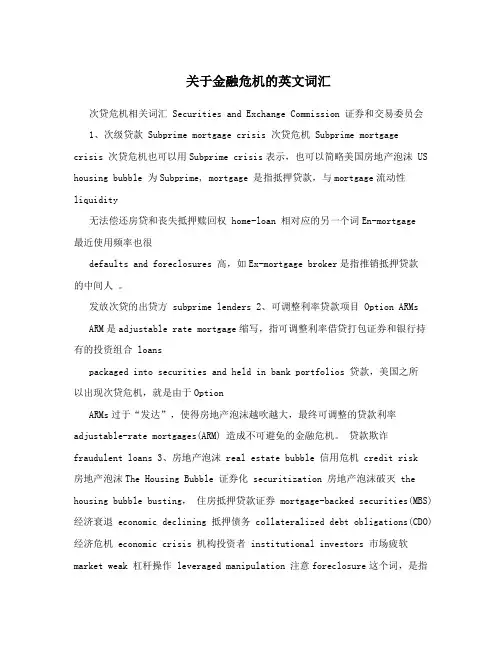
关于金融危机的英文词汇次贷危机相关词汇 Securities and Exchange Commission 证券和交易委员会1、次级贷款 Subprime mortgage crisis 次贷危机 Subprime mortgagecrisis 次贷危机也可以用Subprime crisis表示,也可以简略美国房地产泡沫 US housing bubble 为Subprime, mortgage 是指抵押贷款,与mortgage流动性liquidity无法偿还房贷和丧失抵押赎回权 home-loan 相对应的另一个词En-mortgage最近使用频率也很defaults and foreclosures 高,如Ex-mortgage broker是指推销抵押贷款的中间人。
发放次贷的出贷方 subprime lenders 2、可调整利率贷款项目 Option ARMs ARM是adjustable rate mortgage缩写,指可调整利率借贷打包证券和银行持有的投资组合 loanspackaged into securities and held in bank portfolios 贷款,美国之所以出现次贷危机,就是由于OptionARMs过于“发达”,使得房地产泡沫越吹越大,最终可调整的贷款利率adjustable-rate mortgages(ARM) 造成不可避免的金融危机。
贷款欺诈fraudulent loans 3、房地产泡沫 real estate bubble 信用危机 credit risk房地产泡沫The Housing Bubble 证券化 securitization 房地产泡沫破灭 the housing bubble busting,住房抵押贷款证券 mortgage-backed securities(MBS) 经济衰退 economic declining 抵押债务 collateralized debt obligations(CDO) 经济危机 economic crisis 机构投资者 institutional investors 市场疲软market weak 杠杆操作 leveraged manipulation 注意foreclosure这个词,是指贷方lender没有能力贬值 devaluation 给付月供,银行收回用于出售的房产。
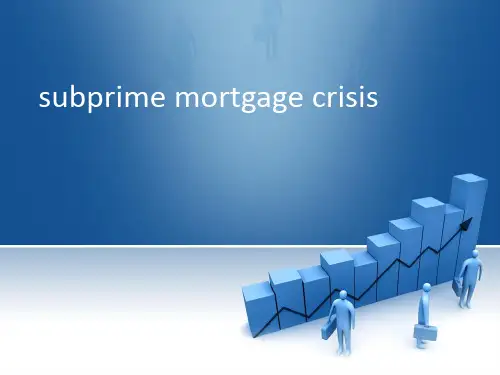
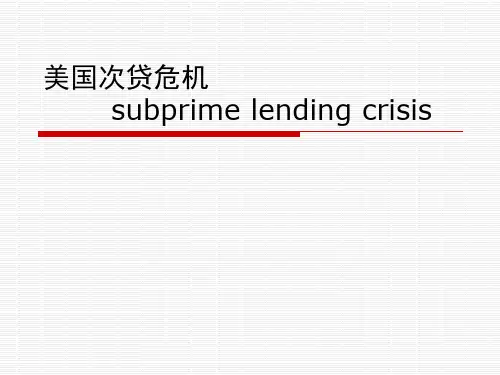

Household debt crisis – a looming threat to the US economyUS economic activity slowed in late 2007 as the credit crisis spawned by the sub-prime mortgage debacle intensified. Banks cut back their lending to individuals and companies, causing the annualized rate of GDP growth to fall to a tepid 0.6% in the fourth quarter last year, significantly lower than the 4.9% recorded in the previous quarter. The worsening outlook has prompted the US government to take unprecedented measures to stimulate the ailing economy.家庭债务危机- 美国经济面对的威胁随着美国次按问题恶化,并引发信贷进一步收缩,美国经济在2007 年年底明显降温。
银行持续减少个人及企业贷款,导致第4季经济生产总值按年率计仅升0.6%,远低于上一季4.9%的增幅。
经济前景转坏,促使美国政府实施多项新政策挽救经济。
US households are the rescue target …A wide range of new measures have been introduced by the US Treasury Department and the Federal Reserve (the Fed) in an attempt to prevent the sub-prime woes from spiraling into a full-blown economic meltdown. First, Congress and the Administration have agreed on a US$152 billion economic stimulus package. This includes tax rebates of up to US$600 per individual and US$300 for each dependent child. Second, the benchmark Fed Funds Rate (FFR) has been slashed by a combined three percentage points in six rate cuts since September 2007 to the current 2.25%. Moreover, liquidity is being pumped into financial institutions by expanding the range of securities accepted as collateral for loans issued by the Fed and by increasing investments in the mortgage market by Fannie Mae and Freddie Mac – the two largest US home finance companies. T he Fed’s support of the bailout of the failing investment bank Bear Sterns marked yet another step to stave off a broader confidence crisis in financial markets.美国政府致力维持家庭消费增长美国财政部及联邦储备局(联储局)采取一连串措施,以阻止次按危机蔓延至其他经济层面。

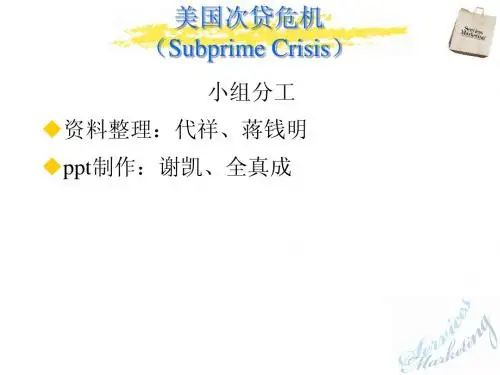

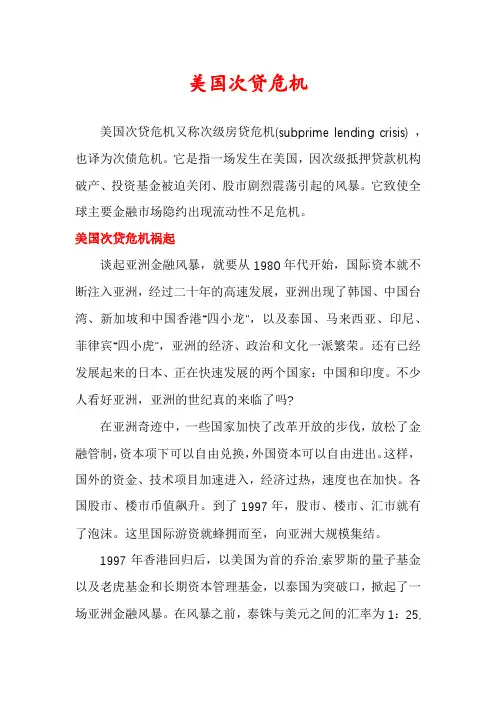
美国次贷危机美国次贷危机又称次级房贷危机(subprime lending crisis) ,也译为次债危机。
它是指一场发生在美国,因次级抵押贷款机构破产、投资基金被迫关闭、股市剧烈震荡引起的风暴。
它致使全球主要金融市场隐约出现流动性不足危机。
美国次贷危机祸起谈起亚洲金融风暴,就要从1980年代开始,国际资本就不断注入亚洲,经过二十年的高速发展,亚洲出现了韩国、中国台湾、新加坡和中国香港“四小龙”,以及泰国、马来西亚、印尼、菲律宾“四小虎”,亚洲的经济、政治和文化一派繁荣。
还有已经发展起来的日本、正在快速发展的两个国家:中国和印度。
不少人看好亚洲,亚洲的世纪真的来临了吗?在亚洲奇迹中,一些国家加快了改革开放的步伐,放松了金融管制,资本项下可以自由兑换,外国资本可以自由进出。
这样,国外的资金、技术项目加速进入,经济过热,速度也在加快。
各国股市、楼市币值飙升。
到了1997年,股市、楼市、汇市就有了泡沫。
这里国际游资就蜂拥而至,向亚洲大规模集结。
1997年香港回归后,以美国为首的乔治.索罗斯的量子基金以及老虎基金和长期资本管理基金,以泰国为突破口,掀起了一场亚洲金融风暴。
在风暴之前,泰铢与美元之间的汇率为1:25,这是固定的,就是1美元可以换25泰铢。
美国经济在20世纪90年代是向上发展的,泰国经济却出了问题,它的房地产有泡沫,经济增长放缓,汇率怎么能维持1:25呢?美国三大基金集结了上千亿美元,第一站冲到泰国。
索罗斯先找泰国银行借入250亿泰铢、抛泰铢。
就时泰国人就慌了,担心泰铢会贬值,都去拿泰铢换美元。
恐慌情绪不断扩大,越来越多的人去换美元。
可泰国银行外汇储备是有限的,等换到最后,没有美元了,泰国就只能放弃固定汇率制,让泰铢自动浮动,泰铢马上贬值。
原来1:25,如果贬到1:50,一美元就可以换50泰铢。
炒家拿5亿美元换成250泰铢还给泰国银行,剩下的那5亿美元就可以归自己了。
在国际炒家的轮番攻击下,泰国政府终于寡不敌众,于1997年7月2日宣布放弃固定汇率制。
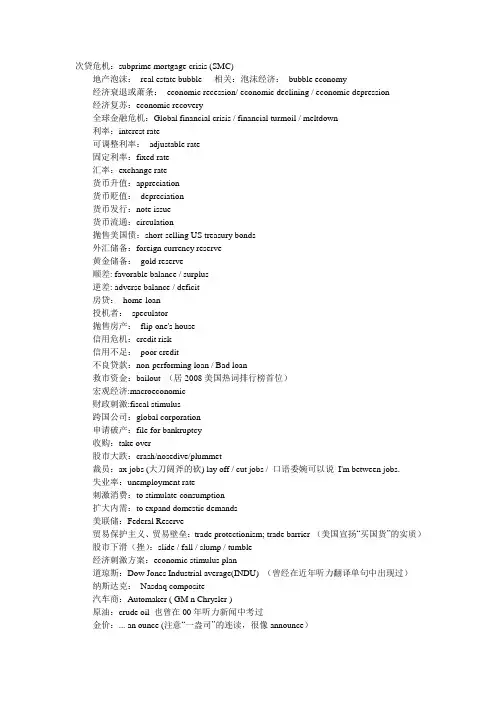
次贷危机:subprime mortgage crisis (SMC)地产泡沫:real estate bubble -- 相关:泡沫经济:bubble economy经济衰退或萧条:economic recession/ economic declining / economic depression经济复苏:economic recovery全球金融危机:Global financial crisis / financial turmoil / meltdown利率:interest rate可调整利率:adjustable rate固定利率:fixed rate汇率:exchange rate货币升值:appreciation货币贬值:depreciation货币发行:note issue货币流通:circulation抛售美国债:short-selling US treasury bonds外汇储备:foreign currency reserve黄金储备:gold reserve顺差: favorable balance / surplus逆差: adverse balance / deficit房贷:home-loan投机者:speculator抛售房产:flip one's house信用危机:credit risk信用不足:poor credit不良贷款:non-performing loan / Bad loan救市资金:bailout (居2008美国热词排行榜首位)宏观经济:macroeconomic财政刺激:fiscal stimulus跨国公司:global corporation申请破产:file for bankruptcy收购:take over股市大跌:crash/nosedive/plummet裁员:ax jobs (大刀阔斧的砍) lay off / cut jobs / 口语委婉可以说I'm between jobs.失业率:unemployment rate刺激消费:to stimulate consumption扩大内需:to expand domestic demands美联储:Federal Reserve贸易保护主义、贸易壁垒:trade protectionism; trade barrier (美国宣扬“买国货”的实质)股市下滑(挫):slide / fall / slump / tumble经济刺激方案:economic stimulus plan道琼斯:Dow Jones Industrial average(INDU) (曾经在近年听力翻译单句中出现过)纳斯达克:Nasdaq composite汽车商:Automaker ( GM n Chrysler )原油:crude oil 也曾在00年听力新闻中考过金价:... an ounce (注意“一盎司”的连读,很像announce)。
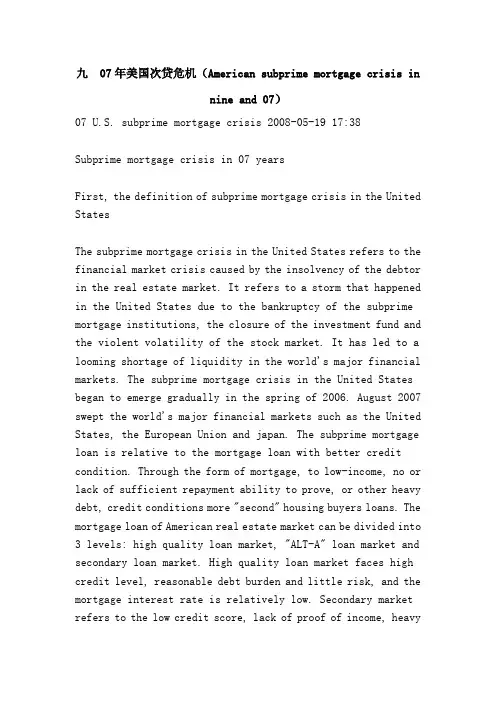
九 07年美国次贷危机(American subprime mortgage crisis innine and 07)07 U.S. subprime mortgage crisis 2008-05-19 17:38Subprime mortgage crisis in 07 yearsFirst, the definition of subprime mortgage crisis in the United StatesThe subprime mortgage crisis in the United States refers to the financial market crisis caused by the insolvency of the debtor in the real estate market. It refers to a storm that happened in the United States due to the bankruptcy of the subprime mortgage institutions, the closure of the investment fund and the violent volatility of the stock market. It has led to a looming shortage of liquidity in the world's major financial markets. The subprime mortgage crisis in the United States began to emerge gradually in the spring of 2006. August 2007 swept the world's major financial markets such as the United States, the European Union and japan. The subprime mortgage loan is relative to the mortgage loan with better credit condition. Through the form of mortgage, to low-income, no or lack of sufficient repayment ability to prove, or other heavy debt, credit conditions more "second" housing buyers loans. The mortgage loan of American real estate market can be divided into 3 levels: high quality loan market, "ALT-A" loan market and secondary loan market. High quality loan market faces high credit level, reasonable debt burden and little risk, and the mortgage interest rate is relatively low. Secondary market refers to the low credit score, lack of proof of income, heavydebt of customers, such as the low income class and new immigrants in the United states. The "ALT-A" loan market is a gray area between the two, refers to the credit record is good, but lack or no fixed income, deposits, assets and other legitimate documents of the client. Subprime markets and ALT-A lending markets are high-risk markets, mortgage rates are higher than high-quality loans, subprime lending crisis is the risk caused by this part of the market.Two, the causes of the subprime mortgage crisis:The direct cause of the U.S. subprime mortgage market turmoil is the rising interest rates in the United States and the continued cooling of the housing market. Subprime mortgages are loans provided by some lending institutions to borrowers with poor credit and low income.Interest increases, resulting in increased repayment pressure, many users who have bad credit feel the pressure of repayment, the possibility of default, the impact of the recovery of bank loans caused crisis.The US subprime mortgage market usually adopts the fixed interest rate and floating interest rate combination of repayment, namely: property buyers in the purchase in the first few years of fixed rate loans, followed by floating rate loans.In the 5 years before 2006, the U.S. subprime mortgage market grew rapidly due to the continued prosperity of the US housing market and the low level of interest rates in the United States in the past few years.With the cooling of the housing market in the United States, especially the short-term interest rate, the repayment interest rate of the subprime mortgage loans has also risen sharply, and the repayment burden of the buyers has been greatly aggravated. At the same time, the continued cooling of the housing market also makes it difficult for homebuyers to sell their homes or refinance through mortgage housing. This situation directly leads to a large number of subprime mortgage borrowers can not repay the loan on time, and then lead to the "subprime mortgage crisis"".Three, the impact of the U.S. subprime mortgage crisis:1, the impact of subprime mortgage crisis on the United states:How broad will the impact of the sub prime crisis in the United States be? This is the current world economic and financial circles pay close attention to the problem.From its direct influence:First of all, the impact is a large number of low-income buyers. Unable to repay their loans, they will face the difficult situation of housing being repossessed by banks.Secondly, more secondary mortgage institutions will be forced to apply for bankruptcy protection because they can not accept loans and suffer serious losses.Finally, because many US and European investment funds havebought a large amount of securities derived from subprime mortgages, they will also suffer heavy losses.This crisis has undoubtedly brought a lot of enlightenment to the domestic financial industry. In the financial innovation, mortgage market development and financial supervision, etc. - since the outbreak of the U.S. subprime mortgage crisis,No matter from the global capital market fluctuations or changes in the United States in the real economy, the loan is not to be underestimated in the United States and worldwide. For China, this storm has sounded the alarm for us to be prepared.The brunt of the subprime mortgage crisis in the United States is the banking sector, and the importance of the risks hidden behind the housing mortgage loan is a problem that should be paid close attention to by the commercial banks in china. In the real estate market overall rising period, housing mortgage loans are high-quality assets of commercial bank loans, a relatively high rate of return, the default rate is low, once the default can also get compensation through the auction of the mortgaged real estate. At present, the real estate mortgage loan occupies a large proportion in the assets of China's commercial banks, and it is also one of the main sources of loan income. According to the new Basel Capital Accord, commercial banks have lower provision for the risk of real estate mortgage loans. However, once the real estate market prices and mortgage rates rising at the same time, property buyers repayment default rate will rise sharply, the total amount of principal and interest after the auction may be lower than the value ofreal estate mortgage principal or, this will lead to a significant increase in the ratio of bad debts of commercial banks, the impact on the profitability of commercial banks and capital adequacy the rate of. However, the real estate market in the near future China possibility of falling prices is unlikely, but in the long term bank mortgage loans risk should not be ignored, must implement strict loan conditions and loan approval system in the present stage.In fact, the source of the subprime mortgage crisis in the United States is that the U.S. real estate financial institutions relaxed the loan conditions in the market boom period, and launched the former tight loan products. The commercial bank China should pay full attention to the lessons from the crisis, the first should strictly ensure Shoufu policy implementation, increase the ratio of loans Shoufu, eliminate zero Shoufu phenomenon; second should take strict pre loan credit audit, avoid false mortgage phenomenon.Before the outbreak of the subprime mortgage crisis, the U.S. economy has been running on the platform with high growth rate, low inflation rate and low unemployment rate for more than 5 years, and the topic of "high fever" in the US housing market has lasted for several years. There is a certain similarity between the economic picture of China and the United States before the housing market cools.The biggest warning of the subprime mortgage crisis in the United States is that we should be vigilant against the impact of macroeconomic regulation and control policies to deal with the economic cycle on a particular market. The root cause ofthe U.S. subprime mortgage crisis is the Fed's interest rate hike leading to the decline of the real estate market. The current Chinese facing accelerating inflation situation, if the central bank in order to curb inflationary pressures and take a substantial measures to improve the RMB loan interest rate, then it should be wary of two aspects: the first is the tightening of lending impact on real estate development enterprises, which may cause developers funding fracture; second is to improve the effect of repayment pressure on the mortgage application the possible mortgage default rates rise. The impact of these two areas will eventually converge to the commercial bank system, resulting in non-performing loans of commercial banks as collateral rates rise, real estate value decline, and ultimately affect the profitability of commercial banks and even survival ability.People need to understand the differences between China and the United States in the economic cycle and the housing market cycle. The United States is a country with a long history of market economy under the global system. It has a strong cyclical nature and is now in the late stage of the prosperity of the current economic cycle.China has not yet experienced a complete economic cycle, even from the reform and opening up to now only 30 years of history, from 1992 and 1993 put forward the market economy to now is only 15 years of history. At this stage, the key word of China's economy is the imbalance between supply and demand, and the demand for fixed investment is large. This is different from the US economy, which focuses on the cycle of nearly 10 years; in addition, the cycles of the housing market in China and theUnited States are different. After the implementation of housing reform in China, the end of the housing market for many years, the demand soared. Although China's housing market is also driven by speculative factors,But large demand and limited supply are the most important reasons for higher housing prices. And for the Chinese housing market, the government has room for regulation.The subprime mortgage crisis in the United States also gives enlightenment to China's Macro-economic Control. There are three main aspects:First, it is necessary to bring asset prices into the monitoring object of the central bank when implementing monetary policy. Because once asset prices affect aggregate demand or aggregate supply through wealth effects or other channels, it will have an impact on inflation. Even if the central bank carrying out the inflation targeting system, it is necessary to take the fluctuation of asset prices as an important reference for the formulation of monetary policy;Second, macroeconomic regulation and control must be taken into account the negative impact of regulatory policy. For example, when the Federal Reserve continues to raise interest rates, the real estate market may not bear enough pressure;Third, the government should not easily provide relief for the crisis. The crisis is a punishment for blind investment and blind diversification. If the government provides relief to such behavior, it will lead to moral hazard. The Central Bankof the developed countries joined the market in capital injection, which may lead to the next bubble.The impact of American subprime mortgage crisis on China in 2 and 07 years:If you add a lot of mortgage loans, the fluctuations in real estate prices have affected half of the bank's credit asset security.The scale of China's real estate loans has developed rapidly in recent years, and has a great impact on the profitability and asset security of the banking industry. According to the Shanghai Banking Bureau released February 2008 "the 2007 Shanghai real estate credit operation report" said that as of 2007 12 at the end of the month, the Chinese funded commercial bank real estate loans 513 billion 762 million yuan, an increase of 45 billion 288 million yuan over the beginning of this year, an increase of 6 billion 328 million yuan, the balance of real estate loans grew 10.58%. In 2007, 27.5% of the incremental loans from Chinese commercial banks in Shanghai were invested in real estate. By the end of 12 last year, the proportion of commercial banks in China's real estate loans accounted for 32.2% of the loans. If you add a lot of mortgage loans, the fluctuations in real estate prices have affected half of the bank's credit asset security. Continue to strengthen in the real estate market volatility and macroeconomic regulation and control at the same time, more correlation between real estate credit operation and the market closely, both the bank and the real estate development enterprises, or mortgage borrowers, are facing the pressure and the risk caused by pricefluctuations. In view of this situation, Shanghai banking regulatory bureau said, will strengthen macro regulation, gather attention credit resources to the real estate industry trends, timely prompt banks pay attention to the potential of the system of credit risk, develop and implement reasonable and scientific credit policy, dispersion, control and management of real estate credit risk.Comparing China's real estate market with the American subprime mortgage market, the two are very different. The most important thing is that mortgage lenders generally apply directly to banks for loans, without sophisticated derivatives. At the same time, the real estate Shoufu in 20%, policy is not allowed to issue zero down payment loans. However, we should also see the risks of China's housing mortgage loan.First, the lower proportion of the loan down payment and false credit, there are a lot of speculative lending. In the real estate "New Deal" before the implementation of China's real estate loans down payment ratio of 20%. But in actual operation, there are also false operations. According to the report, in 2004, Shanghai had had a loan of 78 million yuan, the purchase of 128 houses of major violations of the loan behavior, is through the way of false credit into.Two is the ability to pay loans increased continuously. In accordance with the CBRC guidelines for individual housing mortgage loans, the amount of personal monthly mortgage repayment shall not exceed 50% of the monthly disposable income of individual families. But in fact, domestic residents and housing investors in dealing with housing mortgage loans, manypeople can not meet this basic standard. Some people from the unit or find someone out of random wage income certificate. Bank credit personnel and real estate sales personnel to improve housing sales and loan performance,Even explicitly tell lenders to lend as soon as they can prove it. With false income proof, wage proof and other false documents to the bank mortgage loans, undoubtedly buried huge potential risks.Three is the rapid growth of the loan interest rate, leading to part of the debtor loss of payment capacity. In recent years, the central bank has raised benchmark interest rates several times. October 29, 2004 increased from 5.31% to 5.58%; in April 28, 2006, the benchmark interest rate for financial institutions increased by 0.27 percentage points to 5.85% per year. After 10 consecutive times up, the current one-year benchmark loan interest rate has increased to 7.47%, which is poor credit, repayment ability is not strong lenders, is undoubtedly enormous pressure.Four, house prices are falling after soaring. Statistics show that housing prices in big cities have risen by about 20% in recent years. For specific projects, it rose 50% to 100% or more. The rapid rise in house prices has stimulated buyers' enthusiasm for buying, and real estate has become a way to obtain huge wealth, so that many people with low debt paying ability are involved in the purchase team. When house prices fall, housing market liquidity decreases, loan interest rates rise sharply, it is bound to increase the debt pressure of high priced buyers, so that bank credit faces huge risk of default.The subprime mortgage business in the United States itself is a good thing, and its starting point is to provide loans to people with lower credit ratings or lower incomes, so that they can realize their own dream of owning their own housing. In 1994 ~2006, more than 9 million American families bought new homes, of which about 20% of families took advantage of subprime loans. However, in this process, some negative factors gradually emerge, which eventually led to the outbreak of the crisis.One is excessive securitization. Almost parallel to the subprime lending business is the securitization of American economies, such as the conversion of some obscure debt into securities and then selling them to investors. In other words, any risk can be transformed into securities. So the subprime lending institutions are not idle. They convert their subprime loans to more than six hundred billion dollars into securities and sell them to investors in various countries. So, the banks with investment experience don't see the high risk? The subprime lenders to keep a lot of credit rating agencies, which can easily get the highest credit rating to "AAA", "AAA" certificate of disaster caused by flooding water banks lost sensitivity to risk.Second, inflation. With this piece of "cake" bigger, because rich people have more and more paper assets, and wantonly squandered; the poor are due to see your house every day in appreciation, began to buy usually reluctant to buy things. Finally, the Fed had to raise interest rates to suppress inflation. But after interest rates rise, the poor people who have already been short of money have become unable to affordloans, which has led to a rapid rise in default rates in the subprime mortgage market. So far, the U.S. economy has fallen into a very low liquidity state. With economic development at a low pace, it's harder for poor people to pay off those mountain loans.What can we learn from the subprime mortgage crisis in the United States? Some people may say that we can't learn anything, because China has no subprime market. But take a closer look, and we'll find that there's something like the subprime mortgage in China's economy, and if we don't pay attention to it, the Chinese economy is in a vicious spiral.A typical example is the financial innovation project of China's real estate. Many Chinese want to get wealth by investing in real estate, so it's a good thing for banks to help people realize that. Banks across the country have come up with ideas that attract people to borrow money to buy a house". For example, Shenzhen Bank launched the "Bi weekly for business in 2006, it is allowed to" biweekly "rather than the" month "as a unit of repayment. In this way, borrowers can not only shorten the repayment period, but also pay less interest,So, especially by the "real" welcome. For example, "revolving loan" business, which allows people to mortgage commercial housing to the bank and obtain a certain amount of credit. In this way, borrowers buy more real estate, you can get more loan amount, so more "real estate" sought after. With the help of these financial innovations, real estate prices in Shenzhen have been rising at an alarming rate last year. According to the national development and Reform Commission statistics,Shenzhen new commercial housing prices rose as high as 13.5%, of which more than 60% of the loan house buyers is not the demand for home, but investment demand. By the end of last year, Shenzhen bank mortgage scale has reached 70 billion yuan. Although there is no large-scale loan defaults, but the rising rate of inflation is likely to force the central bank to raise interest rates; interest rates continue to improve, and will lead to many "real users" can not afford to pay interest and breach of contract. At that time, in the absence of the subprime market in Shenzhen City, will not repeat the American sub-prime mortgage crisis, banks can not do real estate loans; will not leave much money to other industries; all economic activities and stagnant because of the lack of cash.Thankfully, in the second half of last year, the central government resolutely implemented the new mortgage policy, the purpose is to suppress the speculative demand of real estate, curb the rising trend of housing prices, and ensure China's financial security. However, the "New Deal" just launched soon, all the opposition began to appear, the purpose of these people is nothing more than hope that the "new home" once again become the "air conditioning", so that they can be at the end of the real estate in big money crazy. In fact, the steady development of China's economy is the greatest happiness of every Chinese. Why should we go against it?Four, how to guard against credit riskThe important implication of the subprime crisis for commercial banks is that ignoring risks in the economic growth stage will inevitably lead to the risk of economic slowdown, even theoutbreak of the crisis. When the economy fluctuates periodically, the loan quality of commercial banks will bear the bruntFirst, we should strengthen the analysis of macroeconomic operation, and pay close attention to the risks that may arise from the economic cycle fluctuations.Two, scientific design of credit products. One of the important reasons for the subprime mortgage crisis in the United States is that the financial institutions are trying to reduce lending standards in order to profit.Three, we should grasp the relationship between macroeconomic trends and specific products.Four, we should do well early warning, control scale and risk.Five, financial innovation should adhere to the principle of "prudent management".The world stock market crash (five, 2007, the U.S. subprime mortgage crisis)The subprime mortgage crisis is a kind of wind that happened in the United States, because of the bankruptcy of the subprime mortgage institutions, the closure of the investment fund and the violent volatility of the stock marketStorm. It has led to a looming shortage of liquidity in the world's major financial markets. The subprime mortgage crisisin the United States began to emerge in the spring of 2006Now. August 2007 swept the world's major financial markets such as the United States, the European Union and japan.With the cooling of the housing market in the United States, especially the short-term interest rate, the repayment interest rate of the subprime mortgage loans has also risen sharply, and the buyers have also paid more attention to itThe loan burden is aggravating. At the same time, the continued cooling of the housing market also makes it difficult for homebuyers to sell their homes or refinance through mortgage housing. suchThe situation directly leads to a large number of subprime mortgage borrowers can not repay the loan on time, and then lead to the "subprime mortgage crisis"".The direct cause of the U.S. subprime mortgage market turmoil is the rising interest rates in the United States and the continued cooling of the housing market.Subprime mortgages are loans provided by some lending institutions to borrowers with poor credit and low income.The American subprime mortgage market usually adopts the combination of fixed interest rate and floating interest rate, that is, the buyers will be in the first few years after buying the houseRepay the loan at a fixed rate, and then repay the loan at a floating rate.Interest increases, resulting in increased repayment pressure, many originally bad credit users feel the pressure of repayment,The possibility of default, the bank loansThe crisis of influence caused by the recovery of funds.The impact of subprime mortgage crisis in the United StatesFirst of all, the impact is a large number of low-income buyers. Unable to repay their loans, they will face a difficult housing recoveryNoodles。
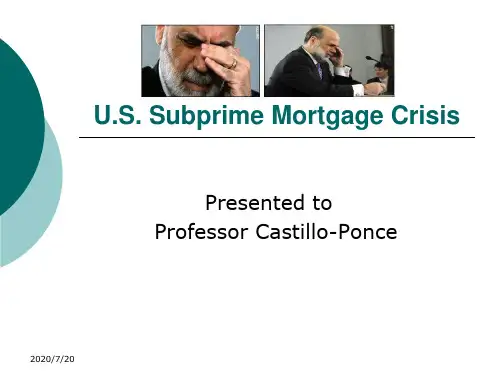
美国次贷危机与全球性的金融危机美国次贷危机(subprime crisis),全称应该是美国房地产市场上的次级按揭贷款的危机(subprime mortgage loan crisis)。
次级按揭贷款,是相对于给资信条件较好的按揭贷款而言的。
因为相对来说,按揭贷款人没有(或缺乏足够的)收入/还款能力证明,或者其他负债较重,所以他们的资信条件较“次”,这类房地产的按揭贷款,就被称为次级按揭贷款。
相对于给资信条件较好的按揭贷款人所能获得的比较优惠的利率和还款方式,次级按揭贷款人在利率和还款方式,通常要被迫支付更高的利率、并遵守更严格的还款方式。
这个本来很自然的问题,却由于美国过去的6、7年以来信贷宽松、金融创新活跃、房地产和证券市场价格上涨的影响,没有得到真正的实施。
这样一来,次级按揭贷款的还款风险就有潜在变成现实。
在这过程中,美国有的金融机构为一己之利,纵容次贷的过度扩张及其关联的贷款打包和债券化规模,使得在一定条件下发生的次级按揭贷款违约事件规模的扩大,到了引发危机的程度。
次级按揭贷款人的资信用状况,本来就比较差,或缺乏足够的收入证明,或还存在其他的负债,还不起房贷、违约是很容易发生的事。
但在信贷环境宽松、或者房价上涨的情况下,放贷机构因贷款人违约收不回贷款,它们也可以通过再融资,或者干脆把抵押的房子收回来,再卖出去即可,不亏还赚。
但在信贷环境改变、特别是房价下降的情况下,再融资、或者把抵押的房子收回来再卖就不容易实现,或者办不到,或者亏损。
在较大规模地、集中地发生这类事件时,危机就出现了。
美国次房危机的苗头,其实早在2006年底就开始了。
只不过,从苗头发生、问题累计到危机确认,特别是到贝尔斯登、美林证券、花旗银行和汇丰银行等国际金融机构对外宣布数以百亿美元的次贷危机损失,花了半年多的时间。
到2007年美国次贷危机全面爆发,其负面影响不断扩大,美国投资银行逐步陷入危机。
2008年3月美国第五大投行贝尔斯登因濒临破产而被摩根大通收购。
美国次贷危机(subprime crisis)又称次级房贷危机,也译为次债危机。
它是指一场发生在美国,因次级抵押贷款机构破产、投资基金被迫关闭、股市剧烈震荡引起的金融风暴。
它致使全球主要金融市场出现流动性不足危机。
美国“次贷危机”是从2006年春季开始逐步显现的。
2007年8月开始席卷美国、欧盟和日本等世界主要金融市场。
次贷危机目前已经成为国际上的一个热点问题。
定义次贷即“次级按揭贷款”(subprime mortgage loan),“次”的意思是指:与“高”、“优”相对应的,形容较差的一方,在“次贷危机”一词中指的是信用低,还债能力低。
次级抵押贷款是一个高风险、高收益的行业,指一些贷款机构向信用程度较差和收入不高的借款人提供的贷款。
与传统意义上的标准抵押贷款的区别在于,次级抵押贷款对贷款者信用记录和还款能力要求不高,贷款利率相应地比一般抵押贷款高很多。
那些因信用记录不好或偿还能力较弱而被银行拒绝提供优质抵押贷款的人,会申请次级抵押贷款购买住房。
次贷的利与弊在房价不断走高时,次级抵押贷款生意兴隆。
即使贷款人现金流并不足以偿还贷款,他们也可以通过房产增值获得再贷款来填补缺口。
但当房价持平或下跌时,就会出现资金缺口而形成坏账。
次级按揭贷款是国外住房按揭的一种类型,贷给没多少收入或个人信用记录较低的人。
之所以贷款给这些人,是因为贷款机构能收取比良好信用等级按揭更高的按揭利息。
在房价高涨的时候,由于抵押品价值充足,贷款不会产生问题;但房价下跌时,抵押品价值不再充足,按揭人收入又不高,面临着贷款违约、房子被银行收回的处境,进而引起按揭提供方的坏账增加,按揭提供方的倒闭案增加、金融市场的系统风险增加。
编辑本段解释模型杠杆许多投资银行为了赚取暴利,采用20-30倍杠杆(Leverage)操作,假设一个银行A自身资产为30亿,30倍杠杆就是900亿。
也就是说,这个银行A以30亿资产为抵押去借900亿的资金用于投资,假如投资盈利5%,那么A就获得45亿的盈利,相对于A自身资产而言,这是150%的暴利。
次贷危机英文作文英文:The subprime crisis, also known as the mortgage crisis, was a financial crisis that occurred in 2008. It was caused by the collapse of the housing market in the United States, which led to a wave of defaults on subprime mortgages. These mortgages were issued to borrowers with poor credit histories who were unable to qualify for traditional mortgages.The crisis had far-reaching consequences, not just in the United States, but around the world. Many financial institutions suffered significant losses, and some even went bankrupt. The crisis also had a ripple effect on the global economy, leading to a recession that lasted for several years.One of the key lessons that we can learn from the subprime crisis is the importance of responsible lendingpractices. Financial institutions need to ensure that they are lending to borrowers who are capable of repaying their loans. They also need to be transparent about the terms and conditions of their loans, so that borrowers can make informed decisions.Another lesson is the importance of regulation. The subprime crisis was in part caused by a lack of regulationin the financial industry. Governments and regulatorybodies need to ensure that financial institutions are operating in a safe and responsible manner.中文:次贷危机,也称为抵押贷款危机,发生于2008年。